The Qualcomm Snapdragon S4 (Krait) Preview Part II
by Anand Lal Shimpi on February 22, 2012 11:40 PM EST- Posted in
- Smartphones
- Snapdragon
- Qualcomm
- Krait
- Mobile
- Tegra 3
- Tablets
- NVIDIA
GPU Performance
Prior to today there was a bug in GLBenchmark that prevented it from running on some Android 4.0.3 devices. Our Eee Pad Transformer Prime was one of those devices and thus we couldn't produce updated Tegra 3 scores using GLBenchmark. Thankfully GLBench 2.1.1 finally made it through testing/validation and includes a slightly different workload, with a number of bug fixes. Android 4.0.3 now works properly and we were able to continue our MSM8960 vs. Tegra 3 comparison. Note that the iOS build of GLBenchmark 2.1.1 is not yet available so we can't provide any iPad 2 comparisons yet.
Tegra 3's GPU performance is much improved compared to Tegra 2, and in the Egypt benchmark we see a tangible advantage over MSM8960. As we mentioned yesterday, only the first Krait SoC will use Adreno 225 - future versions will ship with Adreno 3xx, offering even better GPU performance. As the initial showdown is likely going to be Tegra 3 vs. MSM8960, this is a valid comparison.
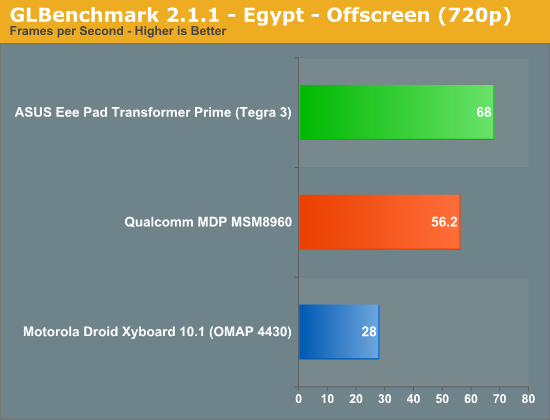
Qualcomm and NVIDIA swap places once again when we look at the older GLBenchmark Pro test, although both perform well thanks to the lighter nature of this test.
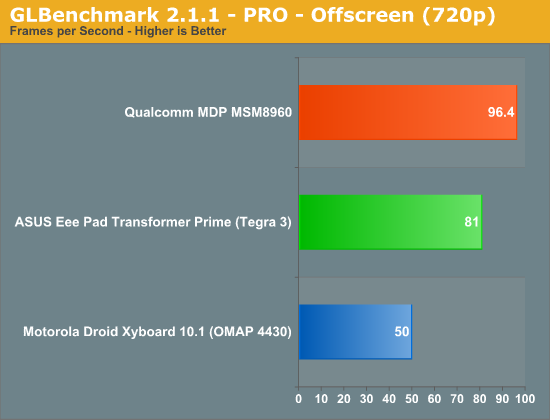
Basemark ES 2.0 is completely dominated by Adreno however:
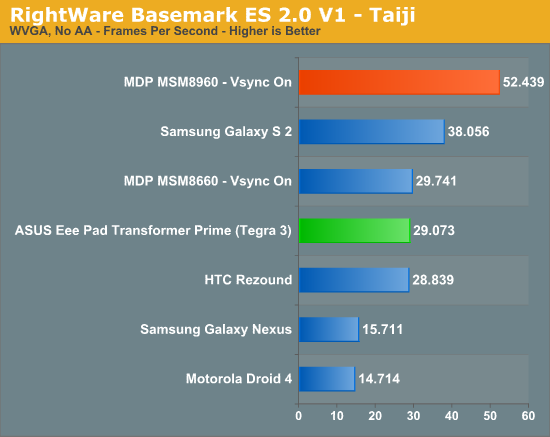
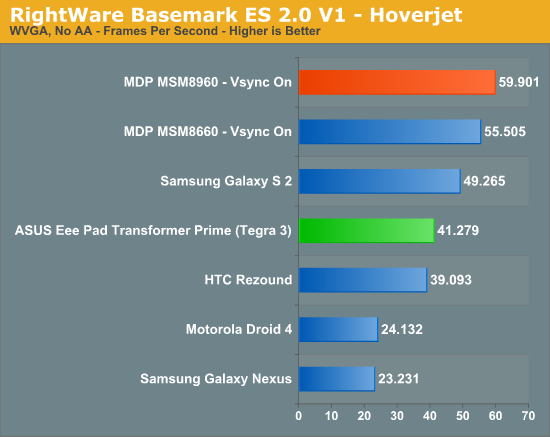
I'm still not totally sure why Basemark favors Adreno architectures so much but the results are what they are.
We've also been playing with Electopia, another Qualcomm-friendly test:
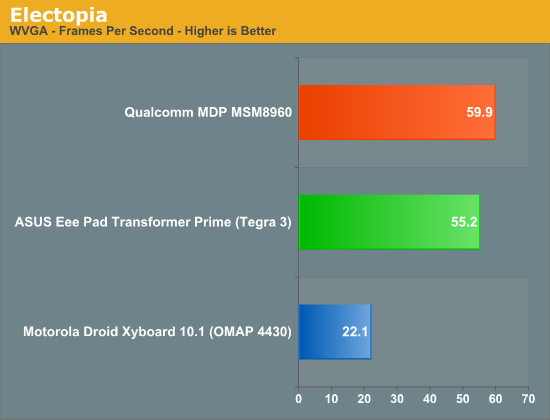
We do bump into Vsync limits with both the Tegra 3 and Qualcomm MDP at 800 x 480. Unfortunately Electopia doesn't allow for custom display resolutions, the only options are WVGA or native. The MDP has a native resolution of 1024 x 600 compared to the TF Prime's 1280 x 800 making a comparison at native resolutions unfair. That being said, according to Qualcomm the MSM8960 should be able to deliver around 40 fps at 1280 x 720 compared to the 24.6 fps we measured on the Transformer Prime at 1280 x 800.
Although Electopia is a game, it's still tough to tell how killer 3D titles on Android will end up performing. Oh the things I would do for an Unreal Engine 3 benchmark on Android...










49 Comments
View All Comments
Alaa - Thursday, February 23, 2012 - link
How about running more than one of these processes at once? Wouldn't 4 cores get more benefit?MonkeyPaw - Thursday, February 23, 2012 - link
The thing is, Tegra 3 is still on a single channel of memory. This was one of the design decisions that made me really question how valuable it was going to 4+1 cores. I think this is probably a very big reason it can't best Krait's 2 cores in any multi-threaded tests. I think they would have been better off going to a 2 core dual channel setup with improved graphics, and saved the move to quad core until Tegra 4.tipoo - Thursday, February 23, 2012 - link
The single channel memory was my first thought also. Four cores active at once plus a GPU all sharing one channel sounds like a terrible idea, that's probably a significant factor.piroroadkill - Thursday, February 23, 2012 - link
Your two cores crapped all over Tegra 3's 5.My god, Tegra 3 looks bloated compared to MSM8960.
I eagerly await devices of all types with this chipset! Bravo!
rahvin - Friday, February 24, 2012 - link
Just like Tegra and Tegra2 nVidia made design decisions to push paper specs over real performance and power savings. Personally other than a few token devices I expect Tegra3 to be a no show once Krait and Omap5 hit the scene.LetsGo - Thursday, February 23, 2012 - link
Looking at the number in the linpack benchmark I would expect the results to scale less than linearly, MDP MSM8960 = 107 MFLOPS single threaded, 218MFLOPS Multi- threaded!That chip has the smarts Impressive!
metafor - Thursday, February 23, 2012 - link
Since two cores share an L2 cache, it's very possible that one core's prefetch also feeds another. I don't think the Linpack program is very intelligent in this regard :/tipoo - Thursday, February 23, 2012 - link
The SGX 543MP2 in the iPad 2 pushes 148 in GLbench Pro offscreen. A year after its first début, why is no one else using it yet? I know the A5 die size is much larger than comparable SoCs because of it, but this here shows everyone else is focusing on CPU performance over GPU, and I think after a certain point the GPU will matter more for rich content.And the iPad 3 will be launching within months no doubt, some saying with a 543MP4 like the Vita has, which would make a large lead into an enormous one. Seriously, what's going on with everyone else?
Death666Angel - Thursday, February 23, 2012 - link
iOS unfortunately is pretty much alone in the mobile gamer department. Android is not really pushing mobile games as much. So big beefy GPUs are not that marketable. :-(Dribble - Thursday, February 23, 2012 - link
I always thought of tegra 3 as a stepping stone between last years standard of dual A9's @ 40nm to tomorrows standard of quad A15's @ 28nm.It looks like we have most of tomorrows chip today as we have a dual A15 equivalent @ 28nm. However is it really shipping soon - 28nm production isn't exactly where it needs to be yet for cheap mobile phone chips? Are the final released products going to be that far ahead of the 28nm A15's?